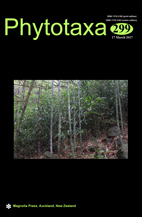Abstract
Hyphodontia zhixiangii is described as a new species from three Uzbek specimens recently collected on Juniperus. This species is characterized by annual, resupinate basidiocarps with a grandinioid to odontioid hymenophore, a monomitic hyphal system with clamp-connected generative hyphae, frequent lagenocystidia and subcapitate septocystidia, and ellipsoid to broadly ellipsoid, thin-walled, smooth basidiospores measuring 4.6–5.5 × 3.3–4 μm. Morphologically, H. zhixiangii resembles H. alutaria and H. arguta. H. alutaria differs mainly in its colliculose hymenophore and slightly smaller basidiospores measuring 4.5–5 × 3–3.5 μm. H. arguta differs in the absence of septocystidia and bearing longer aculei measuring 0.5–2 µm in length. In the ITS-based phylogeny, H. zhixiangii nested within the Hyphodontia clade as a distinct lineage. Three ITS sequences labeled as H. arguta did not cluster together. As it is not known if any of these sequences were obtained from specimens collected in Sweden, the neotype locality, it is impossible to decide which one, if any, represents the genuine H. arguta.

